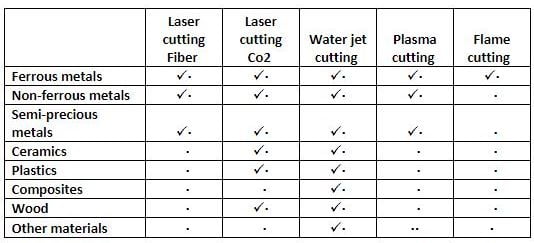Blog by Steve Haddrell.
As an engineer, I learned early in my career that half of the job is choosing the right tool for the job. This is especially true when we consider profiling technology.
There are a number of processes all with their own attributes, that fit certain applications. It’s important to choose the right process for the job to get the best results.
These processes are:
Laser has a couple of common derivatives: Fibre and Co2.
Each has their own place in the toolbox of profiling.

Fibre has come forward in leaps and bounds in the last decade, with this technology improving at a high rate.
Its high-energy efficiency, solid state reliability, and easy integration has made it very much the dominant process for sheet metal.
Its useful range of thickness is 30 mm and below.
Fibre is used for cutting metallics. Mild steel, stainless steel, aluminium, copper, and brass, mainly.
It couples with these materials well, due to this and the advances in high-power output it is very fast, accurate, and relatively clean process.
Co2 is the original process that brought commercially viable laser cutting into industry.
It is capable of processing many of the same materials as Fibre but is not capable of the extremes of power that Fibre is, due to this feed rates are not as high.
Co2 is also not compatible with processing aluminium, copper and brass due to the frequency of the Co2 laser’s light being more easily reflected by these materials than the light frequency of Fibre.
Co2 can process many types of plastic, including material that are clear to human sight.
Plasma is inherently less accurate process than Laser, as it has a wider kerf and introduces a lot of heat into the material processed. This means distortion is inevitable, therefore reducing accuracy
Plasma is capable of cutting thick metallic materials practically up to around 100 mm.
It is predominantly used on mild steel above 4 mm, but can process thinner materials and on materials like aluminium, copper and brass. Feeds are high and edge finishes are good.
Plasma machines are relatively inexpensive and are reliable. They are however generally power hungry.
Waterjet is an extremely versatile process that uses a jet of water with an abrasive garnet medium mixed within it.
I’ve read that 97% of all known materials can be processed with waterjet, not just metallics. Its also capable of processing very thick materials, up to 500 mm. They are also very accurate.
The machines can be very expensive, and they are difficult to operate. The pump units and the cutting tables require regular service.
It is also a messy process, with the cutting medium contaminating the area around the machine. They are best placed away from other machinery.
Flame cutting is only for thicker mild steel. That is mild steel up to 1000 mm thick. The kerf is very wide and there is a lot of thermal energy transferred into the material. Accuracy is low.
The machines are inexpensive and cheap to run.
Check out our tables to show the different processes and their capabilities

